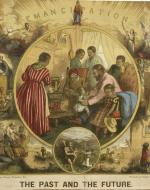Created by Mark Littke on Mon, 05/06/2024 - 01:58
Description:
This image made by the German American immigrant Thomas Nast a few weeks after Lincoln’s delivery of his Emancipation Proclamation shows a striking contrast from the reality of his day in the United States. The image presents a joyful, unified, and peaceful African American family in the center by a stove in their home with the word “Emancipation” written over this center portrait of the work. A baby, representing the New Year, breaks the chains of an emancipated slave below this main portrait. Scenes drawn on the left side of the image portray the brutal past of slavery with depictions of branding, whipping, and the separation of families whereas the right side portrays scenes of future blessings with depictions of pay for work, public education, and enjoying one’s own home (“Thomas Nast: Emancipation of the Negroes”). Ultimately, this image represents the death of slavery in the United States and the rebirth of an idealized society for African Americans in a country in which they still live and work. Excited by the news of emancipation and a waning war, African Americans and more progressive whites immediately began envisioning and talking about a utopia for all races and ethnicities of people in America. One author of The Journal of American History writes that some black citizens now envisioned a society free of racial divisions where they still kept a sense of racial identity in their pride for their fellow black soldiers, black teachers, and black churches (Foner 875-76). The rebirth of a hopeful, more unified country of different races may have faced challenges and disappointments following the emancipation of slaves, but the death of slavery still drove many toward discussing and portraying an ideal society.
In Booker T. Washington’s Up From Slavery, he recalls the blessings he enjoyed and announced in his speeches after spending much of his childhood as a slave. For example, he writes, “This experience of a whole race beginning to go to school for the first time, presents one of the most interesting studies that has ever occurred in connection with the development of any race” (Washington). He now notices and experiences the new birth of an opportunity for some of the most basic civil rights bestowed to most, if not, almost all races in the United States at that time. He witnesses the education, land ownership, freedom of mobility, and increased identity that results from the death of slavery. This recalling is very much akin to the portrayal of a post-slavery country in Nast’s image. Although, unlike the message of this image, Washington also recognizes the challenges and disappointments of the current nation: “It was while my home was at Malden that what was known as the ‘Ku Klux Klan’ was in the height of its activity” (Washington). While part of the promise of an ideal society still remained, much work still needed (and perhaps needs) to be accomplished with the reality of lost relationships, poverty, and other issues on top of the KKK’s activities.
Works Cited
Washington, Booker T. “Up From Slavery: An Autobiography.” Gutenberg.Org, 20 Oct. 2008, www.gutenberg.org/files/2376/2376-h/2376-h.htm.
“Emancipation: The Past and the Future.” Wikipedia, Wikimedia Foundation, 31 July 2023, https://commons.wikimedia.org/wiki/File:Hand_colored_Emancipation_The_Pa....
Foner, Eric. “Rights and the Constitution in Black Life during the Civil War and Reconstruction.” The Journal of American History, vol. 74, no. 3, 1987, pp. 863–83. JSTOR, https://doi.org/10.2307/1902157.
“Thomas Nast: Emancipation of the Negroes – the Past and the Future (from ‘Harper’s Weekly’).” The Metropolitan Museum of Art, Harper’s Weekly, www.metmuseum.org/art/collection/search/429270.
Copyright:
Associated Place(s)
Part of Group:
Featured in Exhibit:
Artist:
- Thomas Nast


